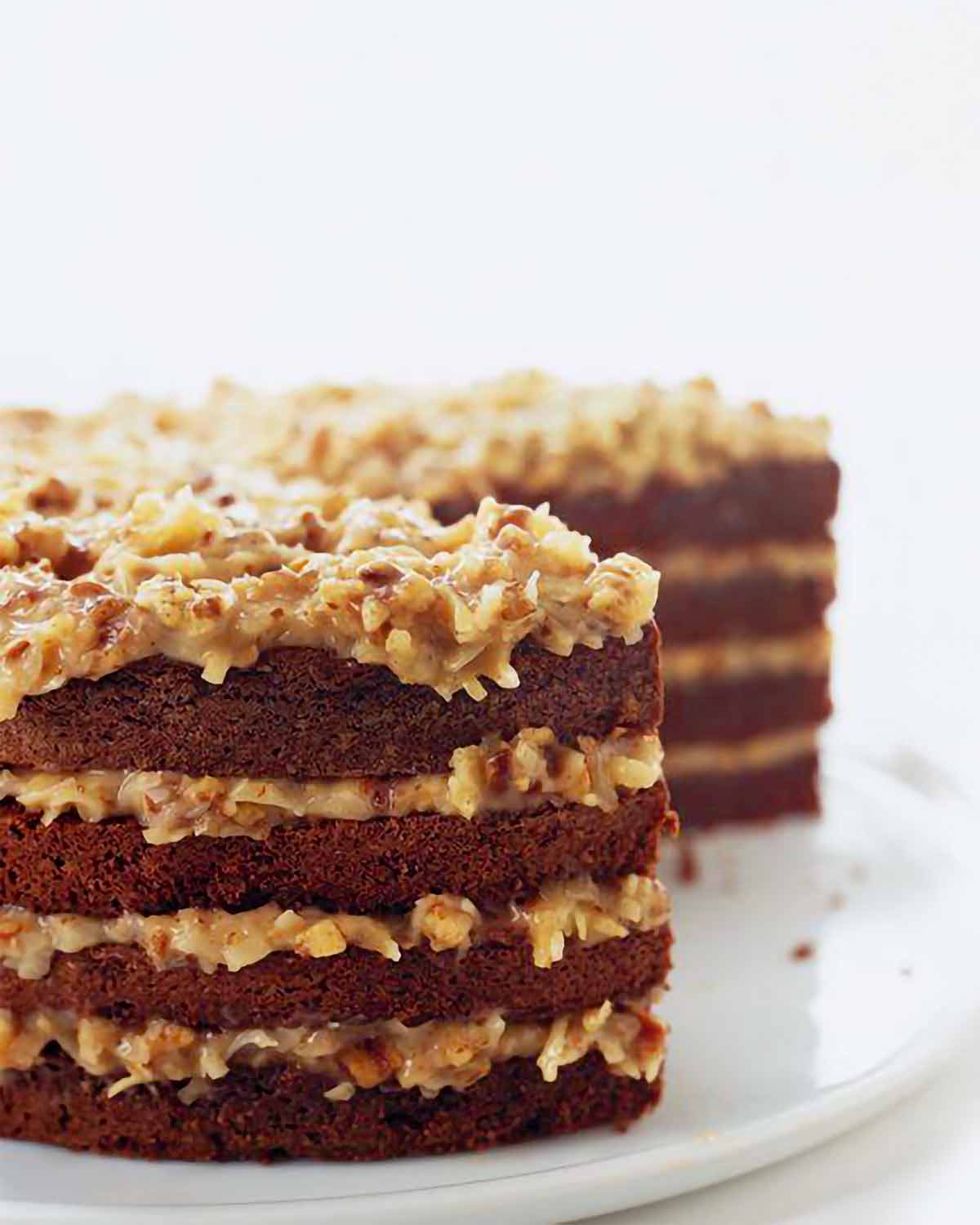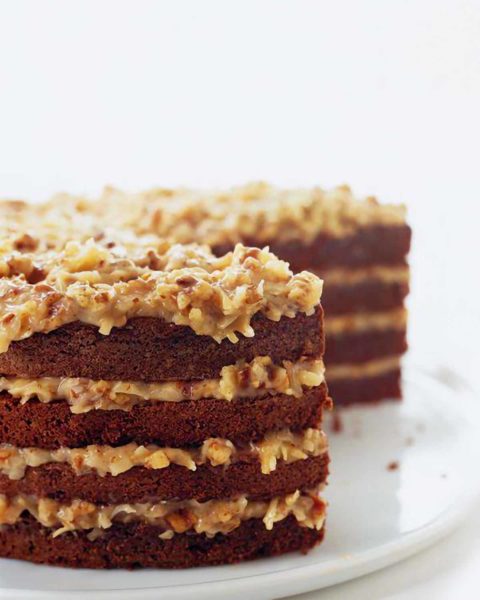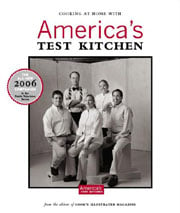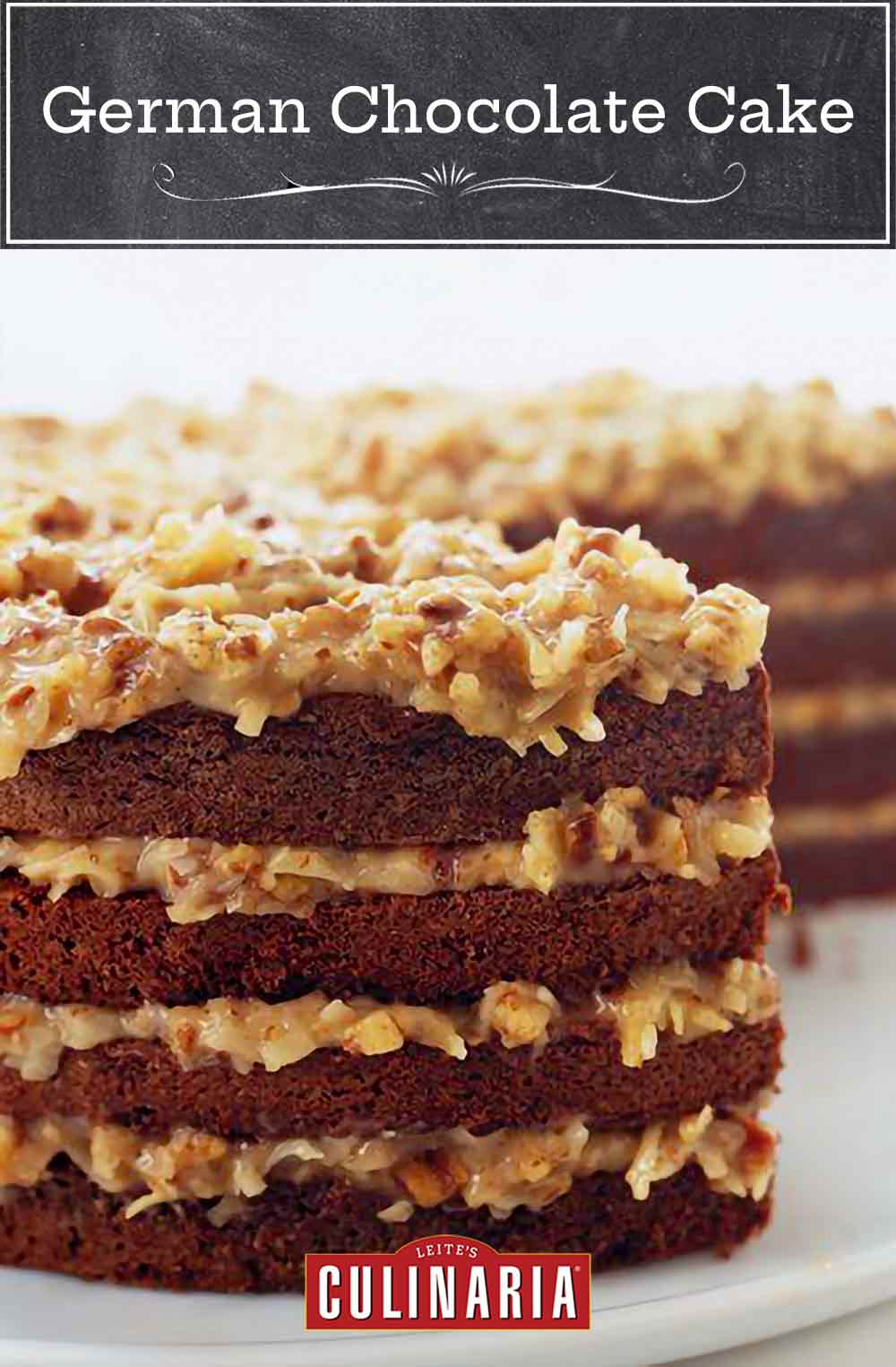
So-called German chocolate cake is, according to many, many sources, actually an American invention. As the story goes, the classic stack of dark chocolate cake smothered with gooey caramel coconut pecan magnificence was named after Baker’s brand German Sweet Chocolate, which was specified in the original German chocolate cake recipe. To unravel the naming even more, the chocolate was named after Sam German, a Baker’s employee who concocted the sweet chocolate back in 1852 or so. Consider that a conversation starter at your gathering when you slice into this lovely little legacy.–Renee Schettler
What makes German chocolate cake different than regular chocolate cake?
It’s not just the frosting that lends these layers of luxuriance their distinctive character. It’s the actual cake itself, which is typically less sweet than your common chocolate cake given its especially dulcet frosting of sugar, coconut, and pecans. This particular version includes cocoa powder as well as dark chocolate for a smoother chocolate experience; however, earlier versions of the cake called solely for melted chocolate. So typically it’s not a cake that you’d make unless it was smothered in the usual German chocolate cake coconut and pecan goodness.

German Chocolate Cake
Ingredients
For the coconut pecan frosting
- 4 large egg yolks
- One (12-ounce) can evaporated milk
- 1 cup granulated sugar
- 1/4 cup packed light brown sugar
- 6 tablespoons (3 oz) unsalted butter, cut into 6 pieces
- 1/8 teaspoon salt
- 2 teaspoons vanilla extract
- 2 1/3 cups sweetened shredded coconut
- 1 1/2 cups (6 oz) finely chopped pecans, toasted
For the German chocolate cake
- 4 ounces semisweet or bittersweet chocolate, chopped fine
- 1/4 cup Dutch-processed cocoa, sifted
- 1/2 cup boiling water
- 2 cups unbleached all-purpose flour, plus more for dusting the pans
- 3/4 teaspoon baking soda
- 12 tablespoons (6 oz) unsalted butter, softened but still cool
- 1 cup granulated sugar
- 2/3 cup packed light brown sugar
- 3/4 teaspoon table salt
- 4 large eggs, room temperature
- 1 teaspoon vanilla extract
- 3/4 cup sour cream, at room temperature
Instructions
Make the coconut pecan frosting
- In a medium saucepan off the stove, whisk the egg yolks. Gradually whisk in the evaporated milk. Add the sugars, butter, and salt and cook over medium-high heat, whisking constantly, until the mixture is boiling, frothy, and slightly thickened, about 6 minutes.
- Pour the mixture into a bowl, whisk in the vanilla, then stir in the coconut. Let cool until room temperature. Cover with plastic wrap and refrigerate until cool, at least 2 hours or up to 3 days. (Do not add the pecans now or they’ll turn soggy. Have patience.)
- Preheat the oven to 350°F (175°C). Toast the pecans on a rimmed baking sheet until fragrant and browned, about 8 minutes. Transfer to a plate to cool.
Make the German chocolate cake
- Keep your oven at 350°F (175°C) and adjust an oven rack to the lower-middle position.
- In a small bowl, combine the chocolate and cocoa in a small bowl and then add the boiling water. Just wait for the chocolate to melt, about 2 minutes. Whisk until smooth and let stand until room temperature.
- Meanwhile, spray two 9-inch-round by 2-inch-high straight-sided cake pans with nonstick cooking spray and then line the bottoms with parchment or waxed paper rounds cut to fit. Spray the paper rounds, dust the pans with flour, and tap out any excess flour. Sift the flour and baking soda into a medium bowl or onto a sheet of parchment or waxed paper.
- In the bowl of a standing mixer, beat the butter, sugars, and salt at medium-low speed until the sugar is moistened, about 30 seconds. Increase the speed to medium-high and beat until the mixture is light and fluffy, about 4 minutes, scraping down the bowl with a rubber spatula halfway through.
- With the mixer running at medium speed, add the eggs one at a time, beating well after each addition and scraping down the bowl halfway through. Beat in the vanilla, then increase the speed to medium-high and beat until light and fluffy, about 45 seconds.
- With the mixer running at low speed, add the chocolate mixture, then increase the speed to medium and beat until combined, about 30 seconds, scraping down the bowl once. (The batter may appear broken or to have separated; this is okay.) With the mixer running at low speed, add the dry ingredients in 3 additions, alternating with the sour cream in 2 additions, beginning and ending with the dry ingredients. Beat in each addition until barely combined. After adding the final flour addition, beat on low until just combined, then stir the batter by hand with a rubber spatula, scraping the bottom and sides of the bowl. The batter will be thick.
- Divide the batter evenly between the prepared cake pans, spreading the batter to the edges of the pans with the rubber spatula and smoothing the surface.
- Bake the cakes until a toothpick inserted into the center of the cakes comes out clean, about 30 minutes. Cool in the pans 10 minutes, then invert the cakes onto a greased wire rack; peel off and discard the paper rounds. Cool the cakes to room temperature before filling, about 1 hour. (The cooled cakes can be wrapped in plastic wrap and stored at room temperature for up to 1 day.)
Assemble the German chocolate cake
- Stir the toasted pecans into the chilled filling. Set 1 cake layer on a serving platter or cardboard round that’s cut slightly smaller than the cake. Place the second cake on a work surface or leave it on the wire rack. Hold a serrated knife held so the blade is parallel with the work surface and use a sawing motion to cut each cake into 2 equal layers. Carefully lift the top layer off each cake.
- Using an icing spatula, distribute about 1 cup filling evenly on the cake layer on the serving platter or cardboard round, spreading the filling to the very edge of the cake and evening the surface. Carefully place the upper cake layer on top of the filling. Repeat using the remaining filling and cake layers. Dust any crumbs from the platter and serve. (The cake may be refrigerated, covered loosely with foil, up to 4 hours. If the cake has been refrigerated longer than 2 hours, let it stand at room temperature for 15 to 20 minutes before slicing and serving.)

Explore More with AI
Nutrition
Nutrition information is automatically calculated, so should only be used as an approximation.
Recipe Testers’ Reviews
This cake is one of those labor-intensive cakes that’s completely worth all the fuss. Seeing the smiles on everyone’s face and experiencing the silence when they had that first bite was worth it. It’s moist with just the right amount of gooey filling. The chocolate flavor in the cake is rich but not overwhelming. My husband loved it. If you want a culinary ace in your pocket, this cake will certainly fill the bill. You’ll impress your guests.
I loved the texture and the moistness of this cake. I found it to be sweet but not too sweet. I’m not a huge German chocolate cake fan, but I treated myself to an extra slice with a large glass of milk.
When I think of German chocolate cake, I think of Thanksgiving and Christmas. I’d most definitely make this one again for the holidays.
Everyone thought the cake’s texture was superior to your average German chocolate cake and the filling was good without being too sweet. I like how I could make the cake and filling in advance and just put it together right before dinner. This will definitely become part of my dessert repertoire when entertaining.











Just a quick question. Do I use the paddle attachment or the whisk attachment on my stand mixer for the cake batter?
Lisa, the paddle attachment. The whisk will whip in too much air.
Tsk… Tsk! A bit of homework is obviously absent in this recipe, sorry! The whole reason for the cake’s NAME; “German Chocolate” Cake is derived from the correct and essential inclusion of sweet German chocolate for the cake batter!!! Bittersweet chocolate has no more place in a German Chocolate Cake than…sauerkraut! The cake portion of the recipe is supposed to be sweet German Chocolate, not dark or bittersweet chocolate.
Is this a nice recipe? Yeah, I’ll give you that. But I’m being polite. This cake, however, it may be that anyone may like it, is a counterfeit and an imposter.
Al, thanks for your rather, um, passionate comment. Clearly, you’re a huge German chocolate cake fan. But one point: German sweet chocolate has 48% cacao content. Semisweet, which the recipe also suggests, has anywhere from 50% to 64% cacao. If you use a lower percentage semisweet chocolate, you’re approaching the original recipe. An imposter? I think not. A variation, I say yes.
I am about to suggest to my little baking buddies that for our week coming soon to all make this cake. I love your version as I am not a fan of completely covered cakes unless it’s a birthday, wedding etc. I absolutely adore German Chocolate Cake. The coconut pecans brown sugar just make me drool. Will let you know what week we might be baking. Have a great week!!
Wonderful, Bea! We’re thrilled and honored! Thanks so much and looking forward to hearing from you!